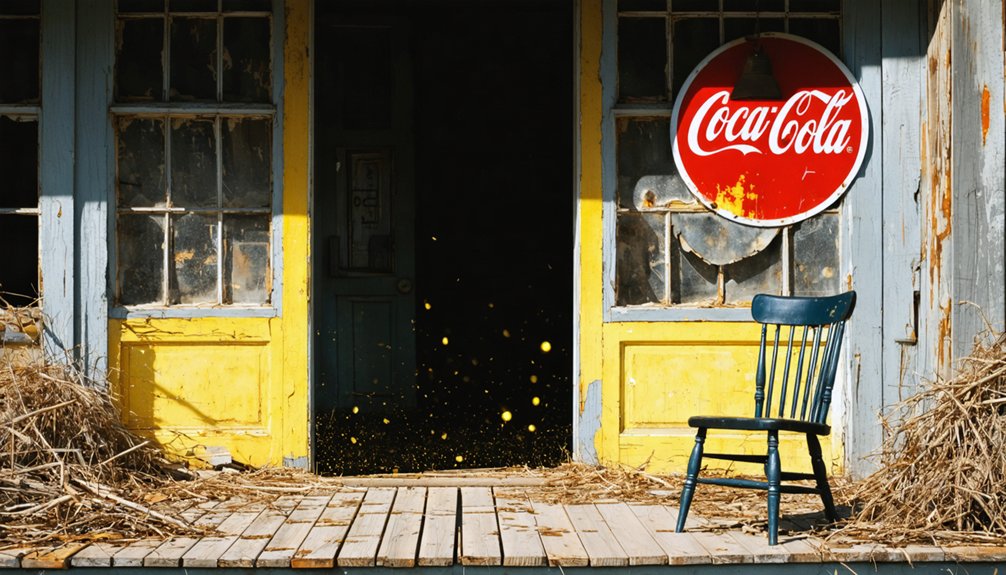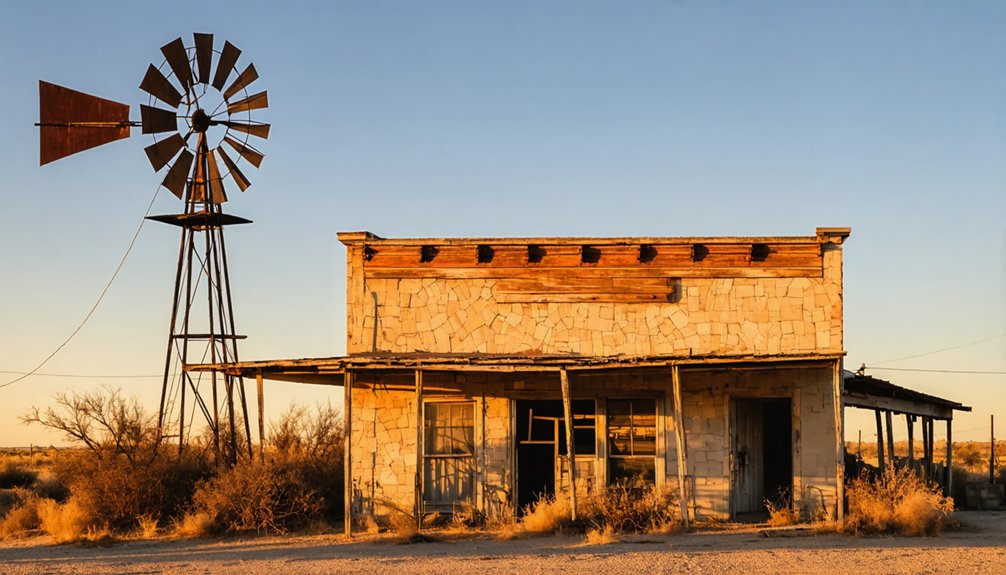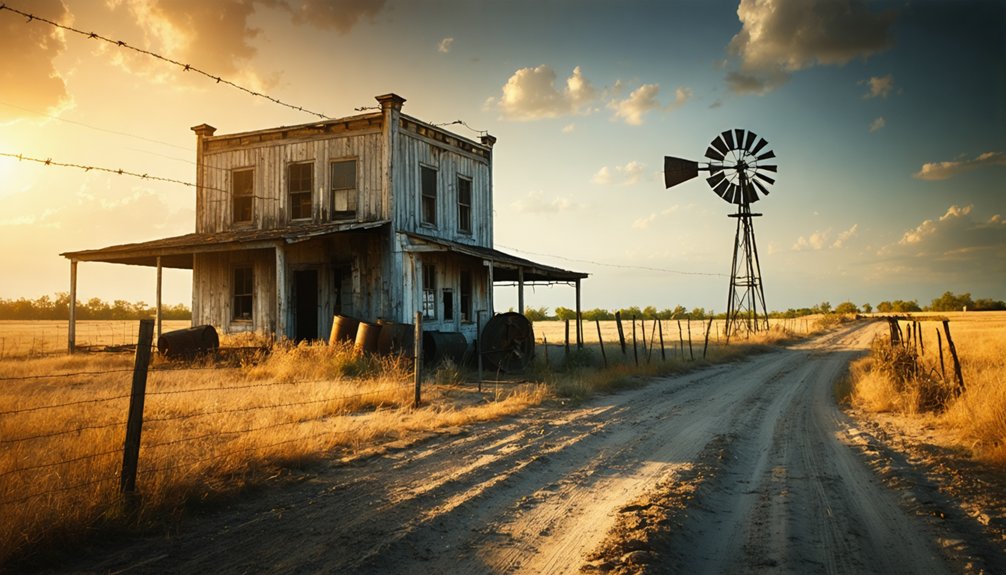You’ll find the ghost town of Padgett 9.5 miles southwest of Olney in Young County, Texas. Founded in 1875 by I. B. Padgett, this agricultural settlement once thrived on cotton production, featuring churches, a two-teacher schoolhouse, and a close-knit farming community. Economic challenges and shifting transportation routes led to its decline in the early 20th century. Today, weathered tombstones and crumbling foundations tell the story of this vanished Texas community.
Key Takeaways
- Padgett was established in 1875 by I.B. Padgett, located 9.5 miles southwest of Olney in Young County, Texas.
- The community thrived through cotton farming and featured multiple churches, a two-teacher schoolhouse, and a close-knit agricultural society.
- Economic decline began in the early 20th century due to falling cotton prices and major transportation routes bypassing the settlement.
- The town’s isolation increased when railroads and highways favored larger settlements, leading to population decline and eventual abandonment.
- Today, Padgett exists as a ghost town with a cemetery, deteriorating structures, and requires careful navigation through rural roads.
The Birth of a Texas Settlement
When I. B. Padgett arrived in Young County, Texas in 1875, he couldn’t have known his name would mark this patch of land for generations.
You’ll find the settlement he founded about 9.5 miles southwest of Olney, where founding families were drawn to the area’s agricultural potential and water access.
The early settlers quickly established their agricultural practices, transforming the Texas prairie into productive farmland.
Without railroads or major infrastructure, these pioneers built their community from scratch – starting with basic homesteads and essential stores.
While detailed records of the first buildings haven’t survived, you can imagine the determination it took to carve out a living here.
Similar to the Badgett surname that was common in other Texas settlements, family names became deeply connected to the communities they helped establish.
The settlement grew organically around farming, with families working together to create a self-sustaining community in the challenging Texas climate.
Like other Texas settlements of the era, the community used a company store system where workers had to make all their purchases with scrip.
Cotton Empire and Early Commerce
As cotton’s influence spread across Texas in the late 1800s, Padgett’s settlers quickly recognized the crop’s economic potential.
You’ll find that cotton cultivation transformed the region, particularly after railroads connected rural communities to major markets like Waco. By the 1890s, farmers from Padgett were hauling their cotton to Waco’s bustling market, where local buyers and merchants competed for the valuable crop. Following Spanish mission traditions, settlers produced several thousand pounds of cotton annually.
Cotton revolutionized Padgett’s economy when railroads linked farmers to Waco’s thriving market, where fierce competition drove the crop’s value skyward.
The economic impact rippled through the community as cotton commerce flourished. The nearby Texas Cotton Palace became a major showcase for the region’s agricultural success starting in 1894.
You’d have seen farmers struggling with market fluctuations and railroad monopolies, even as the overall industry boomed. The establishment of cotton exchanges and bureaus in nearby towns helped stabilize prices, though many small-scale farmers still faced financial hardships.
This period marked Padgett’s integration into Texas’s broader cotton empire, linking the settlement to the state’s rapidly expanding agricultural economy.
Daily Life in 19th Century Padgett
Life in nineteenth-century Padgett centered around a tightly woven community infrastructure anchored by four to five churches and a two-teacher schoolhouse.
Your daily routines would’ve revolved around agricultural practices, with cotton farming and ginning driving the local economy.
Community gatherings strengthened social bonds through:
- Seasonal harvest celebrations and farming activities
- Church services and religious holiday observances
- School functions at Padgett School #28
- Local business interactions at the post office and general stores
You’d have found yourself part of a self-sufficient society where neighbors relied on each other for support and entertainment.
The rhythm of life followed agricultural cycles, while churches served as social hubs where you could connect with fellow residents, sharing both struggles and celebrations in this rural Texas settlement.
I. B. Padgett established the town in 1875, setting the foundation for what would become a thriving rural community.
Like many of the 511 ghost towns in Texas, Padgett’s story of decline reflects the broader patterns of westward expansion and industrialization that shaped the state’s development.
Economic Forces Behind the Decline
You’ll find that Padgett’s economic downturn began when cotton prices plummeted in the early 20th century, severely impacting local farmers who relied heavily on this cash crop.
Similar to Lobo’s fate, where water scarcity led to abandonment, Padgett’s natural resource challenges compounded its economic struggles.
The town’s isolation intensified when major transportation routes shifted away, bypassing Padgett and redirecting crucial trade flows to neighboring communities. Like many of the 511 ghost towns across Texas, Padgett struggled to maintain its population as economic opportunities dwindled.
These economic blows proved devastating, as both the agricultural backbone and commercial accessibility – two pillars of Padgett’s economy – crumbled simultaneously.
Cotton Market Collapse
During the early 20th century, Padgett’s fate became inextricably linked to the devastating cotton market collapse that swept through agricultural communities across the region.
The town’s lack of economic resilience and dependence on cotton left it vulnerable to volatile market dynamics, leading to a rapid downward spiral. Much like the town of Plemons Crossing, the absence of reliable transportation and trade routes contributed to the economic instability. Similar to Katarina, Texas, the Great Depression dealt a severe blow to the already struggling community.
The collapse devastated Padgett’s community in several critical ways:
- Banks withdrew financial support, triggering widespread foreclosures and business closures
- Tenant farmers and sharecroppers faced insolvency as cotton prices plummeted
- Labor migration intensified as workers sought opportunities elsewhere
- Failed attempts at economic diversification accelerated the town’s decline
You’ll find that Padgett’s story mirrors many similar communities that couldn’t survive the perfect storm of overproduction, decreased demand, and financial institution retreat during this tumultuous period.
Transportation Routes Shifted
The transformation of transportation routes played a decisive role in Padgett’s economic decline, compounding the devastating effects of the cotton market collapse. Before 1870, you’d find only wagon trails connecting this isolated farming community to neighboring settlements, with horse-drawn carts moving cotton and supplies.
As transportation innovation swept through Texas, Padgett’s rural isolation deepened. The railroads bypassed the small town, instead favoring larger settlements that quickly became prosperous trade hubs.
When automobiles emerged and state highways developed, Padgett again found itself off the main routes, situated 9.5 miles southwest of Olney on SH 79. The town’s significance dwindled as residents increasingly traveled to larger communities for goods and services.
Vanishing Buildings and Lost Dreams

As time steadily marched forward, Padgett’s once-vibrant buildings succumbed to abandonment and decay, leaving behind little more than foundations and scattered rubble. The town’s lost heritage mirrors countless other Texas ghost towns where shifting economic forces and rerouted transportation left communities to fade into memory.
When you visit today, you’ll encounter a landscape where community memories linger despite the physical void:
- Railroad bypasses triggered the initial exodus, leaving structures to deteriorate.
- Natural weathering accelerated the decay of abandoned buildings.
- Some structures were dismantled and repurposed as residents departed.
- Environmental conditions steadily eroded what remained.
The empty expanse where Padgett once thrived now tells its story primarily through oral histories and scattered documentation, a reflection of how quickly prosperity can vanish when circumstances change.
Legacy in Young County History
While Padgett no longer exists as a physical town, its legacy endures prominently in Young County’s historical narrative. You’ll find its story woven into local historical research, genealogical records, and community memories that paint a picture of rural Texas life.
The town’s evolution from a bustling agricultural center to a ghost town mirrors the broader patterns of demographic change across the state.
Today, you can trace Padgett’s historical significance through its cemetery, which stands as a silent witness to the families who built their lives there.
Cemeteries like Padgett’s serve as enduring monuments, their weathered stones telling stories of pioneers who shaped our community.
Local historians preserve the town’s memory through oral histories and documented accounts, ensuring that future generations understand how these small farming communities shaped Young County’s development.
Padgett’s story continues to inform educational initiatives and heritage tourism efforts focused on Texas’ rural past.
Exploring the Ghost Town Today

You’ll find Padgett’s remaining structures in various states of decay, with roofless buildings and crumbling foundations scattered across the overgrown site.
The ghost town’s remote location requires careful navigation of rural roads, and you should bring appropriate vehicles or be prepared to hike to access the more isolated areas.
When documenting your visit through photography or field notes, you’ll need to work around the absence of informational markers, though local historical archives can provide helpful context for identifying specific ruins.
Physical Remnants Today
Today, visitors to Padgett, Texas will find little evidence of the former settlement beyond its historic cemetery. This burial ground stands as the sole physical remnant, offering a window into the community’s past through its weathered tombstones and historical markers.
The site’s current condition reflects the fate of many Texas ghost towns that emerged and vanished during resource booms. When you explore the area, you’ll notice:
- No original buildings remain standing
- Former town footprint has returned to natural vegetation
- Cemetery access may require traversing private property boundaries
- Grave markers provide genealogical insights into early settlers
Without preservation efforts or interpretive signage, the cemetery’s significance as the last tangible link to Padgett’s history becomes increasingly essential for understanding this vanished community‘s story.
Documenting Modern Site Visits
Modern visitors to Padgett face a challenging yet rewarding exploration experience when documenting this former Texas settlement.
You’ll find the cemetery serves as your primary point of reference, located 9.5 miles southwest of Olney via State Highway 79. For site preservation purposes, you’ll want to bring GPS equipment, as limited signage and navigation aids exist in the area.
Your documentation efforts will benefit from visiting year-round, though weather conditions may affect accessibility.
While exploring, you’ll notice the absence of preserved buildings and marked trails, making visitor engagement more adventurous. Many contribute to ongoing historical records through photographs, oral histories from descendants, and online platforms like Texas Escapes, helping maintain Padgett’s legacy despite natural reclamation of the townsite.
Frequently Asked Questions
What Happened to I.B. Padgett After Founding the Town?
You won’t find clear records of I.B. Padgett’s fate or legacy after founding the town, as historical documents haven’t preserved details about what ultimately became of the town’s namesake founder.
Were There Any Notable Crimes or Lawless Incidents in Padgett?
You won’t find documented crime history or law enforcement records specifically from Padgett. While nearby ghost towns experienced theft and suspicious fires, no notable lawless incidents were confirmed within Padgett’s boundaries.
Did Any Famous People Ever Visit or Stay in Padgett?
Like many small Texas farming communities, you won’t find any documented famous visitors or historical figures in Padgett’s records. No celebrities or notable personalities ever made this modest settlement a destination.
What Native American Tribes Originally Inhabited the Padgett Area?
You’ll find that Comanche and Apache Native tribes originally claimed this territory, with their cultural heritage evident through archaeological findings of hunting grounds and seasonal camps in the area.
How Many People Lived in Padgett During Its Peak Population?
From the horse’s mouth, you’ll find that 150 people marked the peak population before Padgett’s shift toward ghost town status, with numbers dwindling to just 12 residents by 2000.
References
- https://www.youtube.com/watch?v=Ux4FjzHs5DE
- https://texashighways.com/travel-news/four-texas-ghost-towns/
- https://www.ghostsandgetaways.com/ghost-towns
- https://www.ghosttowns.com/states/tx/padgett.html
- https://en.wikipedia.org/wiki/List_of_ghost_towns_in_Texas
- https://discovertexasoutdoors.com/places/padgett/
- https://www.texasescapes.com/TexasTowns/Padgett-Texas.htm
- https://books.google.com/books/about/Leggett_Texas.html?id=4qpCbwAACAAJ
- https://www.youtube.com/watch?v=phjUE19A8HM
- https://en.wikipedia.org/wiki/Badgett



